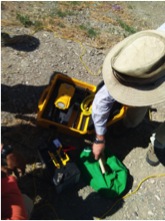The Institute of Petroleum and Geology (IPG) now has a global positioning system (GPS) for monitoring earthquakes. The device is located in the Municipality of Bobonaro, in the western part of the country near the border with Indonesia. It was activated on the 17th of May.
The President of the IPG, Hélio Guterres, expressed his appreciation for the collaboration of the University of Southern California, and thanked Professor Meghan S. Miller and her colleagues of the Department of Geosciences, for their generous support and donation of two geodetic GPS. He also thanked the Australian National University, which contributed to further strengthening the technical capabilities of the IPG in the use, analysis and interpretation of data from the GPS.
For a better understanding of the system, training will be conducted by Professors Simon McClusky and Acraf Koulali, of the Australian National University at the IPG in Aimutin, Dili, between May 19th and 24th.
 Hélio Guterres added that “the IPG will maximize the use of the donated GPS, in their study of the movement of tectonic plates and identification of geological structures, aiming to improve the IPG’s geological research in Timor-Leste.” He said “The study and identification of tectonic faults may contribute significantly to the development of the country, particularly in the planning of infrastructure”.
Hélio Guterres added that “the IPG will maximize the use of the donated GPS, in their study of the movement of tectonic plates and identification of geological structures, aiming to improve the IPG’s geological research in Timor-Leste.” He said “The study and identification of tectonic faults may contribute significantly to the development of the country, particularly in the planning of infrastructure”.
The Director of the Division of Natural Hazards, Eugénio Soares, explained that “the combination of GPS data with focal mechanisms [graphical representations] obtained through the computation and analysis of earthquakes can be useful to identify if the fault is active or not, as well as the relationship between faults and the epicentre of an earthquake. The geodetic GPS can also be useful for the study and monitoring of landslides.”